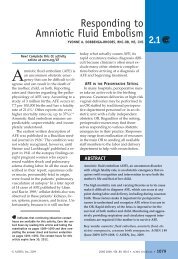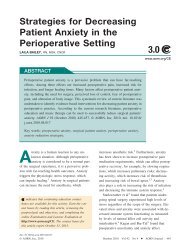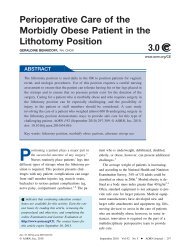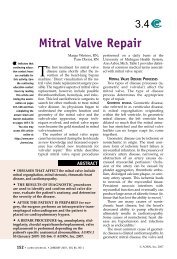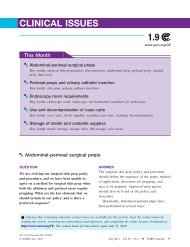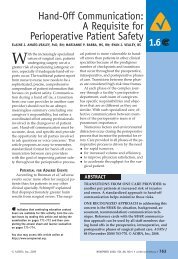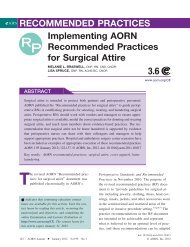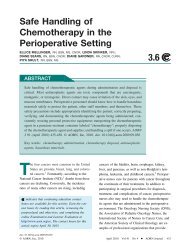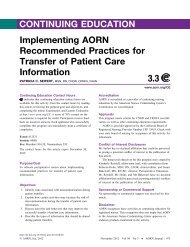Download - AORN
Download - AORN
Download - AORN
Create successful ePaper yourself
Turn your PDF publications into a flip-book with our unique Google optimized e-Paper software.
May 2011 Vol 93 No 5 CLINICAL ISSUESthrough the skin as a liquid. Formaldehyde is a carcinogenthat is linked to nasal cancer and lung cancer,and is a sensitizing agent that can cause an immunesystem response on initial exposure. 4 Acuteexposures to airborne concentrations greater than0.1 ppm are highly irritating to the eyes, nose, andthroat, and can cause coughing and wheezing. Subsequentexposure may cause severe allergic reactionsof the skin, eyes, and respiratory tract. Longtermexposure to low levels of formaldehyde in theair or on the skin can cause asthma-like respiratoryproblems and skin irritation, such as dermatitis anditching. Pulmonary edema has been diagnosed afterexposures to 50 ppm. A 30-minute exposure to100 ppm is immediately dangerous to health andcan be fatal. These levels can be generated by smallformaldehyde spills of only 1 pint or less, even inventilated areas. 4 Blindness can result from splashesin the eyes, and dermal contact causes varying degreesof reactions, including sensitization. 5For these reasons, the safest approach is to dispenseand store formalin in a separate, wellventilatedroom in a centralized location other thanthe OR. The room should have a ventilation systemthat incorporates negative pressure and an exhausthood. 1,3 The material safety data sheet for formalinshould be kept in this room for reference in case ofan accidental spill or injury. 1,6,7 Individual specimencontainers can be filled and stored under controlledconditions close to eyewash, cleanup, and decontaminationfacilities. Using this process minimizesthe risks of hazardous spills or injuries.The OSHA standard requires that employers select, provide, and maintain personal protectiveequipment, including goggles, faceshields, aprons, impervious clothing, andgloves 5 ; ensure that employees use the personal protectiveequipment to prevent skin and eye contactwith formaldehyde 5 ; provide emergency showers 4,5 ; provide eyewash facilities in the immediatework area 4,5 ; label all containers of formalin 5 ; and provide employee education and training thatincludes safe handling, containment andcleanup of a spill, and other measures to minimizerisk of exposure. 1,5<strong>AORN</strong> recommended practices and OSHA standardsshould be followed to minimize hazardousexposure to formalin. The material safety data sheetshould be consulted in the event of a spill for firstaid treatment. 2,7 An emergency clean up protocolshould be included in a policy and procedure. 2,7Formalin should be disposed of according to stateand local regulations. 7MARY J. OGGMSN, RN, CNORPERIOPERATIVE NURSING SPECIALIST<strong>AORN</strong> CENTER FOR NURSING PRACTICEReferences1. Recommended practices for the care and handling ofspecimens in the perioperative environment. In: PerioperativeStandards and Recommended Practices. Denver,CO: <strong>AORN</strong>, Inc; 2011:283-290.2. Formaldehyde: 1910.1048. Occupational Safety andHealth Administration. http://www.osha.gov/pls/oshaweb/owadisp.show_document?p_tableSTANDARDS&p_id10075. Accessed January 7, 2011.3. Guidelines for protecting the safety and health of healthcare workers. National Institute for Occupational Safetyand Health. http://www.cdc.gov/niosh/docs/88-119/pdfs/88-119.pdf. Accessed January 7, 2011.4. Substance technical guidelines for formalin. 29 CFR1910.1048 App A. September 1988. Occupational Safetyand Health Administration. http://www.osha.gov/pls/oshaweb/owadisp.show_document?p_tableSTANDARDS&p_id10076. Accessed January 7, 2011.5. Recommended practices for a safe environment of care. In:Perioperative Standards and Recommended Practices. Denver,CO: <strong>AORN</strong>, Inc; 2011:215-236.6. OSHA directives: Enforcement procedure for occupationalexposure to formaldehyde: CPL 2–2.52.Occupational Safety and Health Administration. http://www.osha.gov/pls/oshaweb/owadisp.show_document?p_tableDIRECTIVES&p_id1566. Accessed January7, 2011.7. OSHA fact sheet: What is formaldehyde? OccupationalSafety and Health Administration. http://www.osha.gov/OshDoc/data_General_Facts/formaldehyde-factsheet.pdf. Accessed January 7, 2011.620 <strong>AORN</strong> Journal



